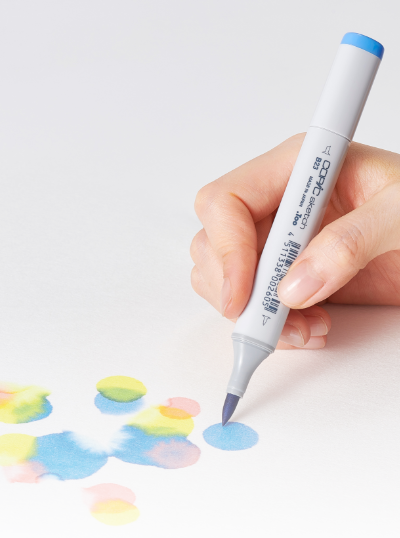Nature, Coloring Leaves pt. 2
15-10-2022
Nature Series: How to color…
Today’s Feature: Leaves part 2

In our previous blog, we explained how to draw and outline 12 different leaves. Today, we will be showing how to color 6 of those leaves using your Copic markers: Oak, Elm, Maple, Walnut, Ginkgo, and Chestnut. Without further ado, let’s get started with the first step below, which is figuring out your color palettes!

The first step before coloring your subject is to figure out the correct palette! Test your marker colors on a separate sheet of marker paper before finalizing each group. Then, when you feel confident in the colors you’ve selected, swatch them in the rectangles on the leaf template in preparation for coloring! *you can find this template here in our line art gallery!

Once the swatching step is complete, we’ll begin coloring each leaf, starting with the darkest color first. For the Oak, Elm, and Walnut, this will be just the stem of the leaf. For the Maple, Ginkgo, and Chestnut, this will be the edges of the leaves.
The reason we suggest starting with the darkest color first is because of the overlapping technique. This technique is exactly as it sounds; you put the darker color down on the paper first, then overlap it with a color slightly lighter than it. Due to the behavior of Copic alcohol markers, the two pigments will blend together, resulting in a lighter version of the darker color and a darker version of the lighter one. This will be better illustrated in the steps below!

The next step after adding our darkest color is to add our mid-tone! To make the transition from your darkest color to the mid-tone the smoothest, use the overlapping technique we just mentioned above. This can clearly be seen in the Maple leaf, where R08 overlapped with E19, and the Chestnut leaf, where YG17 overlapped E08. With the Maple leaf in particular, the artist applied 2 layers of YG17 on top of E08 so that the blend was smoother. Blending colors around the same color family is much easier than two completely different tones, so the more layers you add, the smoother the blend will be!
*Due to all the layering that comes with using Copic markers, we recommend using thicker marker paper or cardstock when you’re blending (see paper suggestions at the end of this blog). The quality of paper you’re working on makes a huge difference!

In the next step, we’ll use the lightest color, following suit with the overlapping technique. For the Elm, Ginkgo, and Chestnut leaves, this means they’re completely colored after at this step. For the Oak, Maple, and Walnut leaves that require more colors there’s one more step after this before they’re fully colored in.

The next step here is to make sure everything is filled in/adding the lightest color. For the Elm, Ginkgo, and Chestnut leaves, the artist went ahead and added another layer of the darkest color to prepare for the step ahead, which will be…

…adding another layer of everything! By repeating the dark, mid-tone(s), and light color(s) steps, the leaf stands out more against the white paper and holds more contrast between all the colors! If you’d like to add even more details to the leaves, you can add colored pencils on top for an even more realistic, textured effect!

Now it’s time for you to test your coloring skills! Apply the lessons learned in today’s blog and practice on the template above, found in our line art gallery. Be sure to download and print this template on good quality paper.

If you don’t want the distinctive black-outlined look for each of these 6 leaves, we have a light gray template option for you to download and print instead! Following the same steps as written throughout this blog, using this light gray template will result in a more realistic looking leaf. The light gray template is similar to a pencil sketch, whereas the black template is similar to outlining your drawing with a pen.

The image above is an example of what each of these leaves can look like with the light gray template. Softer, more realistic-looking leaves, ready for cutting out and hanging around the home for the fall! *No colored pencils or any other mediums were added…this was entirely done with Copic markers!
—
Stay tuned for our next blog, where we’ll be showing you how to color 6 more leaves with Copic markers! Until then!
Read More Articles
Copic Acrea on Canvas
How to use Acrea on various types of Canvas Hello Copic readers! In our previous blog, we wrapped up our discussion on how to use Acrea o...

The Best Papers for COPIC Acrea
How to Layer with Acrea on Various Types of Paper Hello Copic readers! In our previous blog, we wrapped up our discussion on how to use ...

Copic Acrea with Copic Ink
How can Acrea be used with Copic Ink? Greetings Copic readers! In our previous blog, we discussed how Acrea compares with Copic Multil...

Copic Acrea with Multiliners
How does Acrea compare with Copic Multiliner Pens? Greetings Copic readers! In our previous blog, we discussed how Acrea compares to the ...





